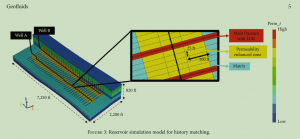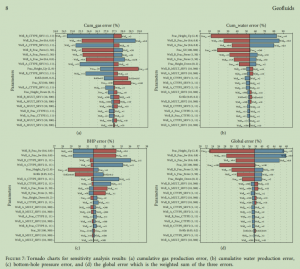Stimulated Reservoir Volume Characterization and Optimum Lateral Well Spacing Study of Two-Well Pad: Midland Basin Case Study
本文介绍了一项基于流动模拟的储层建模研究,该研究针对米德兰盆地一个具有长期生产历史和相同完井参数的两井平台。研究内容包括建立地质模型、历史拟合、井性能预测以及基于油体积和经济指标寻找最优横向井距。储层模型是基于地质模型构建的,整合了目标区域附近的井日志和岩心数据。接着,对储层模拟模型进行了敏感性分析,以更好地理解影响模拟结果的参数。随后进行的历史拟合质量令人满意,全局误差小于10%,并且模型校准后历史拟合参数的范围显著缩小。基于人群的历史拟合算法提供了历史拟合模型的集合,选择了前50个历史拟合模型来预测估计最终恢复量(EUR)的范围,显示油EUR的P50在确定性EUR估计的可接受范围内。利用最佳历史拟合模型,研究了平台的横向井距敏感性,以最大回收量和经济效益为指标。结果表明,鉴于当前的完井设计,比当前区域实践更紧密的井距在油体积回收方面效果不佳。然而,经济指标表明,与当前开发假设相比,可以实现150%的额外货币价值。本研究提供了一种系统的方法,以每段体积和经济指标为依据找到最优横向井距,并且该工作流程可以轻松重复,以评估其他地区的间距优化。
CMG软件的应用情况
在本研究中,CMG IMEX软件被用于构建和模拟储层模型。CMG IMEX是一个黑油模拟器,能够模拟具有局部网格细化(LGR)、模拟双翼水力压裂和复杂水力压裂网络以及全面水平井管理的非常规储层。研究中使用了CMG CMOST模块进行历史拟合,该模块具有内置的进化算法用于优化,称为Design Exploration Controlled Evolution。CMG IMEX作为前向模拟器,模拟受到油速率的约束。此外,CMG软件还用于执行敏感性分析和不确定性分析。


Abstract
This paper introduces a flow simulation-based reservoir modeling study of a two-well pad with long production history and identical completion parameters in the Midland Basin. The study includes building geologic model, history matching, well performance prediction, and finding optimum lateral well spacing in terms of oil volume and economic metrics. The reservoir model was constructed based on a geologic model, integrating well logs, and core data near the target area. Next, a sensitivity analysis was performed on the reservoir simulation model to better understand influential parameters on simulation results. The following history matching was conducted with the satisfactory quality, less than 10% of global error, and after the model calibration ranges of history matching parameters have substantially reduced. The population-based history matching algorithm provides the ensemble of the history-matched model, and the top 50 history-matched models were selected to predict the range of Estimate Ultimate Recovery (EUR), showing that P50 of oil EUR is within the acceptable range of the deterministic EUR estimates. With the best history-matched model, we investigated lateral well spacing sensitivity of the pad in terms of the maximum recovery volume and economic benefit. The results show that, given the current completion design, the well spacing tighter than the current practice in the area is less effective regarding the oil volume recovery. However, economic metrics suggest that the additional monetary value can be realized with 150% of current development assumption. The presented workflow provides a systematic approach to find the optimum lateral well spacing in terms of volume and economic metrics per one section given economic assumptions, and the workflow can be readily repeated to evaluate spacing optimization in other acreage.
Simulator: IMEX
作者单位
第一作者Jaeyoung Park隶属于美国德克萨斯A&M大学石油工程系,地址为3116 TAMU, College Station, TX 77843, USA。第二作者Candra Janova隶属于Parsley Energy, Austin, TX 78701, USA。

